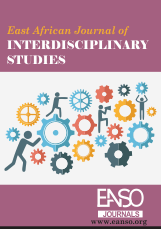Challenges and Barriers to Women's Access and Participation in the ASGM Sector in Macalder Region of Migori County, Kenya
Abstract
Artisanal Small-Scale Gold Mining (ASGM) is a significant source of income for millions of people in developing nations. Globally, women provide approximately 30 to 50% of the workforce in the ASGM sector. Women in developing countries face a number of challenges in access and participation in the ASGM sector. These include; social norms and taboos, inequalities in income distribution, discrimination in access to and control of mineral resources and exposure to gender-based violence. The objective of this study was to assess the challenges and barriers to women's access and participation in the ASGM in the Macalder region of Migori County in Kenya. This study was anchored on the Social Relations Gender approach to argue that the social construction of gender in African societies has tended to disadvantage women in the ASGM sector. This has created a system of subordination and exploitation of women miners in the Macalder region. This study adopted an explanatory research design. The study used both clustered probability and purposive sampling. A total of 100 respondents were selected for field interviews. Clustered probability sampling was used to select 90 men and women gold miners in the Osiri-Matanda gold mines in the Macalder region. Purposive sampling was used to select the lead 10 respondents who included officials of non-governmental organizations and the local administrators for interviews. This study employed both quantitative and qualitative methods of data analysis and interpretation. From the findings, the researcher concluded that cultural and societal notions inhibit women's access and participation in the ASGM sector in the Macalder region. The study recommends that the women miners be empowered to cushion them against exploitation by men. It is further recommended that both National and local governments institute policies and legislation to actualize gender mainstreaming in the ASGM sector to allow women miners to reap economic benefits for socioeconomic development
Downloads
References
Alwang’a, Mulinya and Mabonga, J. (2020). Gold Mining and its Implications on the Environment on Kakamega South Sub-County, Kakamega County, Kenya, Journal of Humanities and Social Sciences. Volume 25, Issue 9, Series 7
Amaldi, David (2015). A Study of pre-Colonial and Contemporary Methods of Gold mining in Ghana. Department of History, University of Ghana,
Aurthur-Hol Francis (2021). Gendered Division of Labor and “Sympathy” In Artisanal and Small-Scale Gold Mining in Prestea-Huni Valley Municipality, Ghana. Journal of Rural Studies Vol 81 Issue 1.
Botha D. (2015). ‘Women in mining: A conceptual framework for gender issues in the South African mining sector, Unpublished PhD thesis, Chapter 2. University of the North West.
Buss D., Rutherford B., Hinton J., Stewart J., Lebert J., Eva Côté G., Sebina-Zziwa A., Kibombo R., & Kisekka F. (2017). Gender and Artisanal and Small-Scale Mining in Central and East Africa: Barriers and Benefits, GrOW Working Paper Series, 2017-02
Buss D., Rutherford B., Hinton J., Stewart J., Lebert J., Eva Côté G., Sebina-Zziwa A., Kibombo R., Hinton J., & Lebert J. (2019). “Gender and Artisanal and Small-Scale Mining; Implications for Formalization”, 6(4) Extractive Industries and Society, 1101-1112.
Buss, Boris (2020). Gendering women’s livelihoods in artisanal and small-scale mining: an introduction. Canadian Journal of African Studies. Vol 54 Issue 20.
Chimhete Nathaniel (2018). Prosperity in a Crisis Economy: The Nyamongo Gold Boom, Tanzania, 1970s–1993.
Eftiemie, A. Heller, K. Strongman, J. (2009). Mainstreaming Gender into Extractive Industries Projects Extractive Industries and Development Series.
Eshun, M. M. (2016). Not Just Counting Their Numbers, But Making Women Artisanal Miners Count.
Fenske, James. (2014). “Ecology, Trade, and States in Pre-Colonial Africa.” Journal of the European Economic Association 12 (3): 612–640.
Gabriele Cifan (2020). The Origins of the Roman Economy. Cambridge University Press, Cambridge.
Gardner Leigh (2022). The Collapse of the Gold Standard in Africa: Money and Colonialism in the Interwar Period. Cambridge University Press, Cambridge.
Geltner G. (2023). Ecological Impacts and Environmental Perceptions of Mining in Europe, 1200-1550. Paregon Journal, Vol 10, Issue 1.
GIZ and Levin Sources. (2019). Gender Safeguards for the Kimberley Process: Global Policy Dimension.
GIZ (2020). Sexual and Gender-Based Violence in the Mining Sector in Africa. Evidence and Reflections from the DRC, South Africa, Tanzania and Uganda. GIZ Report.
Green Erik (2024) Pre-colonial African Economies in Hand Book of African Economic Development (Eds) Carmody Padraig and Murphy James. Cambridge University Press, Cambridge.
Guimbeau Amanda, Ji-Nidhiya James and Meleon Rodgers, (2020). Mining and Gender Gaps in India. Brandeis University, IZA Institute of Economics.
Hinton, J., Veiga, M. M., & Beinhoff, C. (2003). Women and artisanal mining: Gender roles and the road ahead. The socio-economic impacts of artisanal and small-scale mining in developing countries.
Jiekak, S. (2019). Gender Action Plan. USAID Artisanal Mining and Property Rights Task Order under the Strengthening Tenure and Resource Rights II (STARR II) IDIQ
Lahiri-Dutt, K. (2012). Digging Women: Towards a New Agenda for Feminist Critiques of Mining. Gender. Place and Culture. 193-21.
Mukhopadhyay Maitrayee and Wong Franz (2007). “Revisiting Gender Training. The Making and Remaking of Gender Knowledge.” Gender, Society & Development. KIT and Oxfam.
Moretti, D. (2006). The Gender of the Gold: An Ethnographic and Historical Account of Women’s Involvement in Artisanal and Small-scale Mining in Mount Kaindi, Papua New Guinea, Oceania, vol. 76, No. 2, pp 133-149.
Nguyen and Kim Dung (2001). Jewellery from late prehistoric sites recently excavated in Southern Vietnam in Indo-Pacific Prehistory: The Melaka Papers Volume 5. Bulletin of the Indo-Pacific Prehistory Association 21: 107-113.
Palumbo-Roe, Mitchell B.; Bide, T. (2020). Artisanal & small-scale gold mining research field work, Migori County, Kenya. Nottingham, UK, British Geological Survey, 39pp. (OR/20/010) (Unpublished)
Shilaro, Priscila, M. (2007). Colonial Capitalism, Rural Industrialization, African Land Rights in Kenya, and the Kakamega Gold Rush, 1930-1952
Copyright (c) 2025 Samuel Kiplangat Ngetich

This work is licensed under a Creative Commons Attribution 4.0 International License.




























